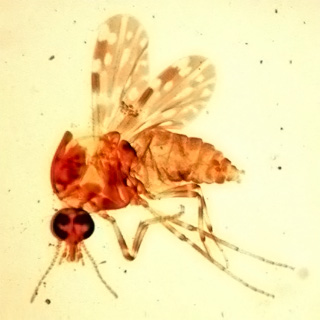
Forty-three nocturnal suction light trap collections were made in a horse stable at Bet Dagan, Israel, in order to determine the hourly flight activity of Culicoides imicola. Although C. imicola is active during the entire night, peak numbers of midges were found 1–3 hours after sunset, which were significantly higher than the numbers caught at 4–6 hours after sunset. The latter were significantly higher than those caught at 7–9 hours, and these were significantly higher than at 10–12 hours. No significant differences were found in the number of C. imicola at the various hour groups between summer (July 1 – September 15) and autumn (September 16 – November 30), as well as between 1996 and 2000–2001 (Braverman et al. 2008).
The method of segregating nulliparous and parous females of Culicoides spp. based on the presence of burgundy-red pigment inside the abdominal wall of parous Culicoides midges, is used worldwide. Out of 320 females of Culicoides imicola trapped by emergence traps, set over an artificial breeding site for 10 and 24 days, 73 (22.8%) showed a red pigmentation despite the fact that they were nulliparous. This finding indicated that 23% of the "parous" females that are examined for the presence of arboviruses and other pathogens or for age-grading purposes are actually old nulliparous females, which had no chance of acquiring pathogens. This bias in parous rate distorts upward the calculation of vectorial capacity (Braverman & Mumcuoglu, 2009).
Certain mites (Acari) are parasitic on insects and other arthropods or use them as a means for transport to habitats where they find more suitable environmental conditions. This article reports on phoretic and parasitic mites collected from Diptera in Israel and Egypt. Flies from the families Muscidae, Ceratopogonidae, Sphaeroceridae, Milichiidae, Sepsidae and Ulidiidae were collected in the periphery of cowsheds and horse stables using William’s fiberglass panel (Alsynite) trap, Monks Wood and DuToit suction traps. Specimens of the house fly (Musca domestica) and of the stable fly (Stomoxys calcitrans) were infested mainly by Macrocheles muscaedomesticae, and to a lesser extent by Macrocheles subbadius, trombiculid larvae and by Dendrolaelaps nymphs. Most Culicoides species (Ceratopogonidae) were infested by water-mite larvae of the families Limnesiidae, Thyasidae and Arrenuridae, as well as by larvae of the terrestrial Trombidiidae and Neotrombidiidae, whereas representatives of the remaining dipteran families were infested mainly by astigmatid, prostigmatid and mesostigmatid mites (Mumcuoglu & Braverman, 2010).
Host preference determines which host will be bitten and therefore potentially be infected with vectored pathogenic microorganisms by hematophagous arthropods such as Culicoides. In Israel, the feeding behavior of 8 out of 60 Culicoides species was confirmed by using the precipitin tests. In the present study several morphometric parameters, which characterize bird and mammal feeders were used. By means of the number of antennomer bearing sensilla coeloconica, the following fourteen probable mammal feeders could be detected: Culicoides derisor, Culicoides fagineus, Culicoides fascipennis group, Culicoides imicola, Culicoides montanus, Culicoides newsteadi, Culicoides obsoletus, Culicoides pulicaris, Culicoides punctatus, Culicoides puncticollis, Culicoides schultzei group, Culicoides shaklawensis, Culicoides pallidicornis, and Culicoides vitreipennis. In addition, the following eighteen probable bird feeders were identified: Culicoides begueti, Culicoides brunnicans, Culicoides cataneii, Culicoides circumscriptus, Culicoides kibunensis, Culicoides distinctipennis, Culicoides gejgelensis, Culicoides haranti, Culicoides indistinctus, Culicoides odiatus, Culicoides maritimus, Culicoides festivipennis, Culicoides pseudopallidu, Culicoides griseidorsum, Culicoides sejfadinei, Culicoides simulator and Culicoides univittatus. The probable bird feeders possessed a significantly larger third palpal segment. The values of the antennal ratio in feeders on birds were significantly higher than those in probable mammal feeders. The number of bulb-shaped sensilla in the pit of the third palpal segment was found unreliable for determining host groups (Braverman et al. 2013).
A study was conducted in order to improve our ability to better identify the breeding sites of the major Culicoides (Diptera: Ceratopogonidae) vectors, in order to enable their control. The samples were assessed by putting them into a rearing bucket and/or by using emergence trap. The most prevalent midge, Culicoides circumscriptus (Kieffer), was most prolific in mud with medium organic matter with frequency of 61% (p<0.001). Culicoides imicola (Kieffer) breeds mainly in damp mixture of rotten, decomposed animal dung with or without some mud, with frequency of 64.8% (p<0.001). Culicoides obsoletus (Meigen) was found mostly in rotten banana stumps, with frequency of 99.5% (p<0.001). Culicoides puncticollis (Becker) was found in mud with a medium amount of organic matter with frequency of 80.7% (p<0.001). Culicoides distinctipennis (Austen) showed no significant differences between the categories of breeding sites. Culicoides schultzei gr was most prolifically in mud rich in organic matter with frequency of 68.9% (p<0.001). Culicoides cataneii (Clastrier) was most prolifically in mud with a medium amount of organic matter with frequency of 67.6% (p<0.001). Duration time to emergence from the breeding sites ranged from seven weeks in C. obsoletus to fourteen weeks in C. circumscriptus and nine weeks in C. imicola. All the studied species breed throughout the year and their seasonality was analyzed statistically. Significant (p<0.001) innate differences in the proportions of the sexes were found in the emergence of six species. Most breeding sites of the studied Culicoides spp. are manmade and located within or close to the perimeter of the livestock farms. Taking into account the maintenance system of livestock, the climate and the breeding sites in Israel, leads to the conclusion that control measures would be effective in reducing drastically the vector species populations (Braverman et al. 2017, submitted).
The larval developmental sites of Culicoides species were assessed from 1155 samples collected during the years 1969-2003. Culicoides circumscriptus was most prolific in mud with medium organic matter with proportional representation of 55.8%. Culicoides imicola breeds mainly in damp mixture of rotten, decomposed animal dung with or without some mud, with proportional representation of 97.2%. Culicoides obsoletus was found mostly in rotten banana stumps, with proportional representation of almost 100%. Culicoides puncticollis was found in mud with a medium amount of organic matter with proportional representation of 35.6%. Culicoides distinctipennis showed 22.2% proportional representation for mud poor in organic matter. Culicoides schultzei gr. was most prolifically in mud rich in organic matter with proportional representation of 6.2%. Culicoides cataneii was most prolifically in mud with a medium amount of organic matter with proportional representation of 1.8%. Maximum duration time to emergence from the larval developmental sites ranged from seven weeks in C. obsoletus to fourteen weeks in C. circumscriptus and nine weeks in C. imicola. All the studied species breed throughout the year (Braverman et al. 2018)
References:
Braverman, Y. & K.Y. Mumcuoglu. 2009. Newly emerged nulliparous Culicoides imicola Kieffer (Diptera: Ceratopogonidae) with pigmented abdomen. Med. Vet. Entomol. 160: 356-358. DOI:10.1016/j.vetpar.2008.11.016.
Mumcuoglu, K.Y. & Y. Braverman. 2010. Parasitic and phoretic mites of Diptera in Israel and the Sinai Peninsula, Egypt. Isr. J. Entomol. 40: 195-203.
Braverman, Y., A. Chizov-Ginsburg, M. Friger & K.Y. Mumcuoglu. 2008. Nocturnal activity of Culicoides imicola Kieffer (Diptera: Ceratopogonidae) in Israel. Russian Entomol. J. 17: 37-39.
Braverman, Y., A. Frish, M. Reis & K.Y. Mumcuoglu. 2012. Host preference of Culicoides spp. from Israel based on sensory organs and morphometry (Diptera: Ceratopogonidae). Entomol. Gener. 34; 97 – 110.
Braverman, Y., A. Chizov-Ginzburg, H. Eldor, M. Friger & K.Y. Mumcuoglu. 2017. Features of breeding sites of biting midges species from Israel and the eastern Mediterranean with implications to their control (Med. Vet. Entomol., submitted).
Braverman, Y., A. Chizov-Ginzburg, H. Eldor & K.Y. Mumcuoglu. 2018. Overview and features of larval developmental sites of biting midges species associated with livestock in Israel with implications to their control. Veterinary Parasitology: Regional Studies and Reports 14 (2018) 204–211.

